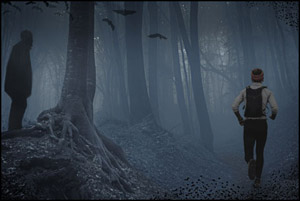Once, the swarm had been controlled by the local bats.

Art by Tamara Rees of VIN
PARK CLOSED AFTER SUNSET
The sound of her pursuers drew closer, moving faster than she would have believed possible. It had been less than a minute since activation and the distant thrum of the swarm was coalescing into a sharp whine that pierced through her ears and into her spinal cord.
She shifted the straps of her canvas bag on sweaty shoulders as she willed her feet to keep moving. They would find her soon enough. She didn’t have to make it easy.
A crisp breeze stabbed the back of her neck, but she knew it wouldn’t be enough. The swarm’s infectivity decreased in the cold of winter, but the day that had lured her into the park with its summer warmth would have ensured the viability of tonight’s activation.
Once, the swarm had been controlled by the local bats. The black, leather clouds had inhabited all of the city’s bridges and underhangs, until one case of rabies in a schoolchild set off social media and townhall panic with parents demanding SOMETHING be done.
Janet had been one of the biochemists involved in that something. As she raced down the trail, feet catching on rocks and roots, she bitterly regretted her part in the banishment of the bats. Tinkering with prions had just been stupid. Prions, packets of pure protein and often malevolent protein at that, were, as her boyfriend used to say, proof that nature is a jerk.
He was right, and he had been one of the first casualties of the swarm. In an attempt to rid the city of rabies-carrying bats, the team had infected the insects that were the bats' main food source with altered prions targeting the bats’ DNA.
The plan worked too well. In the core areas of the city, the bats were wiped out. But the night-biting insects flourished. And something had happened to them.
They thought the prion infection would be limited to one or two generations of insects, that without a new source of infection, the insect population would return to normal.
They were wrong.
The viral carrier they had used to insert the prions into the insects had mutated. Now formerly annoying biting insects had become a deadly pestilence. Each evening until the first hard freeze, the virus activated within the bugs, driving them into a swarm with a taste for human blood.
The people who were bitten, if they didn’t die from exsanguination by the swarm, developed raging headaches, delusions, and became uncontrollably violent. The city had gone from lamp-lit sidewalks and manicured parks to a ruin of broken windows, burnt out buildings and blood-spattered streets within weeks. Most of the people left had fled, seeking regions with healthy bat populations.
The bats themselves had been transformed rather than killed or sterilized by the plague. Their nightly insect patrols no longer looped outward from the bridges in neat spirals. Instead the remaining bats resembled a raggedy gang, biting pets and livestock, chasing stragglers at night.
In perhaps the worst irony of all, with the modified bats there were now more rabies cases than ever before.
Janet had stayed, hoping against hope that she could find a way to control the evil her team had unleashed. During the days, she tagged sleeping bats with tracking devices and captured dormant insects near the marshy ponds. At night, she worked frantically in the relative safety of her lab.
That impulse to atone was now her doom.
The drone of the swarm was louder now than her own pounding feet. Just ahead the trees broke into the open clearing that led to the parking lot and the relative safety of her car. Janet pushed her legs forward as sweat stung her eyes.
The faintest of flutterings overhead reminded her that there was more to fear in the night than the activated swarm, but she couldn’t spare a breath, let alone a glance, for the bats she now knew were above. Her shoulders hunched around her neck, she ran on, trying to summon a last burst of speed. The pock-marked asphalt was steps away. She hadn’t yet felt the stings on her flesh. There was hope.
A root snagged her foot, tripping her. As Janet’s hands hit the dirt, she knew it was over. She stared into a pair of bloodshot blue eyes then looked back at the grubby fingers grasping her ankle.
“They’re too close,” her attacker said. “Come.” The hand pulled her leg off the path, forcing her to roll into the bushes. Mint and lavender filled her nose. “They don’t like the herbs,” said the voice. The hand grabbed her wrist pulling her up. “Car?” he asked.
“Over there,“ she pointed from the bushes.
“Keys.” He held out his hand. Dazed, she dropped them into the waiting palm.
They ran toward the lone vehicle, Janet a few steps behind. Glancing at her license plate, he said one word as he dove into the car and hit the lock button.
“You!” rang in her ears as she watched the car emblazoned with the catchy BATPRION plates disappear.
She dropped to the asphalt as the swarm descended. The potholes filled with blood.